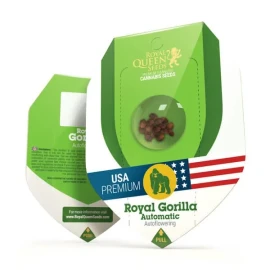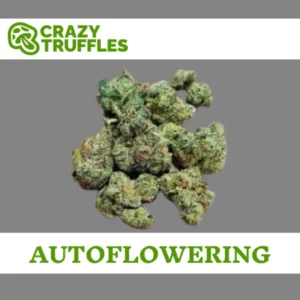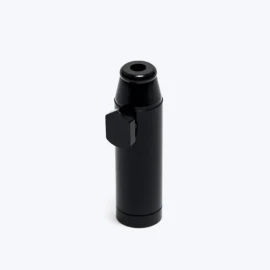Watermelon
12,00 €
Quick Facts
Type: Indica-dominant hybrid (approximately 70-80% indica)
Typical THC: 22-26% (reports up to ~29% — unverified)
CBD: <1%
Dominant Terpenes: Myrcene, limonene, caryophyllene
Flowering Time: 8-9 weeks
Yield: ~450-500 g/m² indoors; up to ~500 g/plant outdoors
Notable Traits: Intensely fruity watermelon aroma, sticky trichome coating, sweet/juicy smoke, strong body relaxation
Introduction
The Watermelon strain delivers an experience that tastes exactly like its name suggests—imagine the mouthwatering sweetness of ripe watermelon captured in cannabis form. This indica-dominant hybrid has earned its reputation through an irresistible combination of fruity flavors and deeply relaxing effects that make it perfect for unwinding after a long day. Whether you’re a curious beginner exploring flavor-forward strains or an experienced user seeking reliable relaxation, Watermelon offers a sensory-rich journey from aroma to effect that consistently delivers on its promise of sweet, sedating satisfaction.
What Is Watermelon? Origins & Genetics
The Watermelon strain traces its lineage to the reported Watermelon OG S1, incorporating classic OG Kush genetics with berry-type traits that create its distinctive profile. Like many cannabis origin stories, the exact breeding details remain somewhat vague, with various sources attributing different genetic combinations to achieve this particular phenotype. What remains consistent across reports is the strain’s connection to OG genetics, which explains its potent effects and resinous bud structure.
What makes Watermelon truly unique lies in its exceptional terpene profile that produces an unmistakable watermelon and candy-like aroma. The strain’s ability to consistently deliver this specific flavor combination, paired with dense, trichome-rich buds and reliably high THC content, has made it a favorite among users seeking both recreational enjoyment and therapeutic relaxation. The indica-dominant genetics ensure that the sweet, fruity experience leads to substantial body effects that can satisfy even experienced users.
Aroma, Flavor & Visual Profile
Aroma Profile
The Watermelon strain greets you with an immediately recognizable burst of fresh watermelon sweetness that fills the room upon opening your container. The primary aroma closely resembles biting into a perfectly ripe watermelon on a summer day, with natural fruit sugars creating an almost candy-like sweetness. Complementing this dominant watermelon scent, you’ll detect bright citrusy top notes contributed by limonene, adding a zesty freshness that prevents the sweetness from becoming overwhelming.
Beneath these prominent fruit notes, subtle spicy and earthy undertones emerge, courtesy of caryophyllene. These deeper notes provide complexity and balance, creating a well-rounded aromatic experience that evolves as you continue to smell the flower.
Flavor Experience
When consumed, Watermelon delivers on its aromatic promise with a sweet, juicy inhale that tastes remarkably like sipping fresh watermelon juice. The flavor profile maintains its fruit-forward character throughout the experience, often described as sugary watermelon or tropical fruit punch. The exhale tends to emphasize the candy-like qualities, leaving a pleasant sweetness that lingers on the palate.
The smoke itself is typically smooth and easy on the throat, making it accessible for newer users while providing the robust flavor that experienced consumers appreciate. The strain’s terpene profile ensures that the taste remains consistent from first hit to last.
Visual Characteristics
Watermelon buds display the dense, compact structure typical of indica-dominant genetics. The flowers showcase a beautiful contrast of bright and dark green leaves, often accented by vibrant orange pistils that weave throughout the bud structure. What immediately catches the eye is the heavy coating of trichomes that makes the buds appear almost frosted, contributing to their notably sticky texture when handled.
The buds tend to be medium to large in size with excellent density that speaks to the strain’s quality and potency. When properly cured, Watermelon flowers maintain their structural integrity while remaining pleasantly sticky to the touch—a clear indicator of their resin content and freshness.
Cannabinoids & Terpene Science — Simple Explainer
Cannabinoid Profile
Watermelon typically contains THC levels ranging from 22-26%, placing it firmly in the high-potency category that can deliver strong euphoric and physical effects. Some reports suggest THC levels reaching up to 29%, though these higher numbers remain unverified through consistent lab testing. This elevated THC content explains the strain’s ability to produce both cerebral euphoria and significant body relaxation.
CBD levels remain consistently low at less than 1%, meaning the experience is primarily driven by THC’s psychoactive properties rather than the balancing effects that higher CBD ratios might provide. Users should expect a full-strength cannabis experience focused on recreational and therapeutic effects.
It’s important to note that comprehensive recent lab data for this strain remains limited, so we recommend checking local lab results when available to understand the specific cannabinoid profile of your particular batch.
Terpene Contributions
The strain’s distinctive character comes from its dominant terpene profile, which directly influences both aroma and effects:
Myrcene serves as the primary terpene, contributing to the strain’s sedative and relaxing body effects. This terpene is known for enhancing THC’s absorption and creating the “couch-lock” sensations that make Watermelon ideal for evening use.
Limonene provides the bright citrus notes in the aroma while potentially offering mood-elevating properties that can complement the relaxing effects with subtle mental uplift.
Caryophyllene adds the spicy, peppery undertones and uniquely interacts with CB2 receptors in the body, potentially contributing anti-inflammatory benefits that may enhance the strain’s therapeutic applications.
This terpene combination creates a synergistic effect where the aromatic experience directly translates to the physiological and psychological effects users experience.
Effects: What to Expect
Overall Experience Profile
Watermelon delivers a classic indica-dominant experience that begins with a euphoric head high before transitioning into deep, full-body relaxation. The initial onset typically brings a gentle cerebral buzz that can enhance mood and promote feelings of contentment without overwhelming mental stimulation. This makes it accessible for users who want to remain functional while experiencing cannabis effects.
As the experience progresses, the indica genetics assert themselves through increasingly pronounced physical effects. Users commonly report a warm, heavy sensation that starts in the head and shoulders before spreading throughout the body, creating the deeply relaxing state that makes this strain particularly valuable for stress relief and unwinding.
Recreational Applications
Watermelon excels as an evening strain, perfect for transitioning from the day’s activities into relaxation mode. It’s particularly well-suited for social situations where gentle euphoria and relaxation are desired—think casual gatherings with friends, movie nights, or creative activities that benefit from a relaxed mindset.
The strain’s pleasant flavor profile makes it enjoyable for users who prioritize taste alongside effects, while its potent but manageable high makes it suitable for both solo sessions and shared experiences. Many users find it ideal for enhancing music listening, enjoying food, or engaging in low-key creative pursuits.
Medical Applications
Users commonly report Watermelon’s effectiveness for anxiety reduction, with many finding that its combination of mental euphoria and physical relaxation helps quiet racing thoughts and promote calm. The strain’s sedating properties make it frequently chosen for stress relief after difficult days or challenging periods.
For sleep support, Watermelon’s indica-dominant effects and myrcene content often help users transition into restful sleep, particularly when consumed 1-2 hours before intended bedtime. The strain’s ability to promote appetite stimulation also makes it valuable for users dealing with appetite loss or nausea.
Note: These applications represent commonly reported user experiences rather than medical claims. Always consult healthcare professionals for medical cannabis guidance.
Onset and Duration
When smoked or vaped, Watermelon typically produces effects within minutes, with full effects developing over 15-30 minutes. The experience generally lasts 2-4 hours depending on dosage, tolerance, and consumption method. Edible preparations will have significantly longer onset times (30-120 minutes) but extended duration (4-8 hours).
Optimal Usage Times
Watermelon performs best as an evening or weekend strain when relaxation and unwinding are the primary goals. It’s particularly valuable after work for stress decompression, during lazy weekend afternoons, or as a pre-sleep ritual for those seeking sedating effects. The strain’s potency makes it less suitable for morning or midday use when productivity and alertness are required.
Dosage Guidance for Beginners
New users should start with small amounts—just a few small puffs when smoking or vaping—and wait 15-30 minutes to assess effects before consuming more. The strain’s high THC content can produce strong effects even in small doses, making the “start low, go slow” approach essential for avoiding overwhelming experiences.
Growing Watermelon — Beginner to Intermediate Guide
Suitability and Overview
Watermelon presents a manageable growing experience for intermediate beginners who have basic cannabis cultivation knowledge. While not the simplest strain for absolute newcomers, it rewards attentive care with impressive yields and potent, flavorful results. The strain performs well in both indoor and outdoor environments, though indoor cultivation allows for better control of the environmental factors that optimize its dense bud development.
Environment and Setup
Lighting Requirements: Standard photoperiod lighting works best, with 18/6 light cycles during vegetative growth transitioning to 12/12 for flowering. Ensure adequate light penetration for the strain’s dense canopy development.
Temperature Control: Maintain temperatures between 20-26°C (68-79°F) during lights-on periods, with nighttime temperatures 3-5 degrees cooler. Stable temperatures prevent stress that could impact terpene development and overall yield.
Humidity Management: Start with 50-60% relative humidity during early vegetative growth, gradually reducing to 40-55% during late vegetative stages. During flowering, maintain 40-45% humidity to prevent mold development on the strain’s dense buds, particularly during the final weeks.
Growing Medium and Containers
Watermelon thrives in well-draining soil or coco coir mixtures that provide good nutrient retention while preventing waterlogging. For indoor cultivation, use 7-11 liter containers that provide adequate root space without becoming unwieldy. Outdoor growers should consider 10-20 liter containers or direct soil planting in well-prepared garden beds.
High-quality potting soil amended with perlite for drainage typically provides excellent results, while experienced growers may prefer coco coir for more precise nutrient control.
Nutrition Program
During vegetative growth, provide balanced NPK nutrition with slightly higher nitrogen to support leaf and stem development. Watermelon responds well to regular feeding but can suffer from nutrient burn if overfed, so start with 50-70% of manufacturer’s recommended feeding schedules.
As flowering begins, transition to bloom nutrients with reduced nitrogen and increased phosphorus and potassium to support bud development and terpene production. Monitor plants for signs of nutrient deficiency or excess, adjusting feeding strength accordingly.
Training Techniques
Early Vegetative Training: Top or FIM the main stem once plants reach 3-5 nodes to encourage multiple cola development and create an even canopy. This technique is particularly effective for Watermelon’s naturally bushy growth pattern.
Low Stress Training (LST): Gently bend and secure branches to spread the canopy and improve light distribution. Begin LST early in vegetative growth and continue throughout the vegetative period. This technique works exceptionally well for beginners as it’s forgiving and highly effective.
Screen of Green (SCROG): Indoor growers can implement SCROG techniques to maximize yields by training branches through a horizontal screen, creating an even canopy that optimizes light distribution and supports the strain’s heavy bud development.
Flowering Timeline and Expectations
Watermelon completes flowering in 8-9 weeks, with most phenotypes finishing closer to the 8-week mark under optimal conditions. During early flowering (weeks 1-3), focus on maintaining proper environmental conditions and supporting stretch growth with adequate nutrition.
Mid-flowering (weeks 4-6) brings rapid bud development where maintaining lower humidity becomes crucial. Late flowering (weeks 7-9) sees final bulk and trichome development—monitor trichome maturity rather than relying solely on calendar timing.
Yield Expectations: Indoor growers can expect approximately 450-500 grams per square meter under optimal conditions with proper training. Outdoor cultivation in favorable climates can produce up to 500 grams per plant, though results vary significantly based on environmental factors and plant size.
Pest and Disease Prevention
The strain’s dense bud structure requires particular attention to airflow and humidity control to prevent bud rot and powdery mildew. Ensure adequate ventilation throughout the growing space and avoid overhead watering during flowering.
Regular inspection for common pests like spider mites, aphids, and thrips allows for early intervention if problems arise. Preventive measures like beneficial insects and organic pest deterrents work better than reactive treatments.
Beginner Success Checklist
- Maintain stable light schedules without interruption during flowering
- Ensure consistent airflow throughout the growing space
- Monitor and log temperature and humidity daily
- Follow a regular feeding schedule adapted to plant response
- Implement LST early for better light distribution
- Check plants daily for signs of stress, pests, or deficiencies
- Plan for adequate drying and curing space before harvest
Harvesting, Drying & Curing
Determining Harvest Timing
Proper harvest timing maximizes both potency and flavor in Watermelon buds. Use trichome examination as your primary indicator—look for mostly milky white trichomes with 10-20% amber coloration for peak THC content and balanced effects. Plants harvested with fewer amber trichomes will provide more energetic effects, while higher amber percentages increase sedative qualities.
Pistil color provides a secondary indicator, with 70-80% of pistils darkening from white to orange or brown indicating approaching maturity. However, trichome examination remains the most reliable method for determining optimal harvest timing.
Harvest Process
Cut branches individually rather than harvesting entire plants at once, allowing for easier handling and more controlled drying. Remove large fan leaves during harvest but leave smaller sugar leaves for protection during drying—these can be trimmed after drying for better bud appearance.
Handle buds gently to preserve trichome integrity, as Watermelon’s sticky resin coating can be easily damaged with rough handling.
Drying Protocol
Hang trimmed branches upside down in a dark, well-ventilated room maintained at 18-21°C with 45-55% relative humidity. Proper airflow prevents mold development while controlled temperature and humidity preserve terpenes and prevent over-rapid drying.
Drying typically takes 7-14 days, with completion indicated when smaller stems snap cleanly rather than bending. Rushed drying at high temperatures will degrade terpenes and result in harsh, less flavorful smoke.
Curing for Optimal Quality
Transfer dried buds to airtight glass jars filled 75% full to allow air circulation. During the first week, open jars daily for 10-15 minutes to release moisture and exchange air. Continue this “burping” process for 2-3 weeks, then reduce to weekly opening.
Minimum curing time is 2 weeks for smokeable results, but 4-8 weeks of curing significantly improves flavor development and smoke smoothness. Properly cured Watermelon will maintain its distinctive aroma while developing more complex flavor notes.
Store cured cannabis in cool, dark locations to preserve potency and prevent terpene degradation over time.
Comparisons — Watermelon vs Similar Strains
Watermelon vs Watermelon OG
Watermelon OG maintains stronger connections to classic OG Kush genetics, resulting in heavier body effects and more pronounced earthy undertones alongside the fruity profile. The OG version typically produces slightly denser buds with potentially higher yields but may sacrifice some of the pure watermelon flavor clarity found in standard Watermelon phenotypes.
Growing characteristics remain similar, though Watermelon OG may stretch more during early flowering and require additional support for heavy branches.
Watermelon vs Watermelon Zkittlez
Watermelon Zkittlez emphasizes sweeter, more tropical candy notes with enhanced terpene diversity that creates a broader fruit flavor spectrum. This variant often provides slightly more energetic effects compared to the heavier body sensations of standard Watermelon, making it potentially more suitable for daytime use.
The Zkittlez influence typically results in more colorful buds with purple and pink hues, particularly when exposed to cooler temperatures during flowering.
Watermelon vs Watermelon Kush
Kush variants generally display stronger sedative effects and more pronounced earthy, spicy notes that complement rather than compete with the fruity profile. Watermelon Kush strains often finish slightly faster (7-8 weeks) but may produce lower yields due to the indica-heavy genetics.
These versions excel for users specifically seeking maximum relaxation and sleep support, though they may lack some of the bright, uplifting qualities found in balanced Watermelon phenotypes.
Comparison with Other Fruity Strains
Watermelon vs Zkittlez: Standard Zkittlez offers broader fruit complexity while Watermelon provides more focused melon-specific flavors with comparable potency and growing requirements.
Watermelon vs Gushers: Gushers typically delivers more intense cerebral effects with berry-dominant flavors, while Watermelon emphasizes body relaxation with cleaner fruit notes.
Watermelon vs Gelato: Gelato provides more balanced hybrid effects with dessert-like flavors, whereas Watermelon leans heavily into indica territory with pure fruit expression.
Creative Uses: Cooking & Infusion Ideas
Safety and Preparation Fundamentals
Creating edibles with Watermelon requires proper decarboxylation to activate THC and careful dosing to ensure safe, enjoyable experiences. Always start with small amounts and wait 2-3 hours before consuming additional edibles, as onset times vary significantly between individuals.
Calculate approximate THC content before beginning: if using 1 gram of flower testing at 25% THC, expect roughly 250mg total THC in your infusion. Divide this by the number of servings to determine per-serving dosage—beginners should aim for 2.5-5mg THC per serving.
Decarboxylation Process
Preheat your oven to 115°C (240°F) and spread ground cannabis evenly on a parchment-lined baking sheet. Bake for 30-40 minutes, stirring once halfway through to ensure even heating. Properly decarboxylated material will appear slightly golden and aromatic.
Use an oven thermometer to verify temperature accuracy, as variations can affect THC activation and terpene preservation.
Basic Infusion Methods
Cannabis Butter: Combine decarboxylated Watermelon with butter in a slow cooker or double boiler, maintaining 70-90°C for 2-3 hours. Strain through cheesecloth and refrigerate until solid. The resulting butter captures both cannabinoids and water-soluble terpenes.
Cannabis Oil: Use the same low-temperature, long-duration approach with coconut oil or other cooking oils. Coconut oil works particularly well due to its high saturated fat content that efficiently absorbs cannabinoids.
Recipe Applications
Watermelon’s sweet, fruity profile complements dessert applications exceptionally well. Consider incorporating watermelon butter into fruit tarts, berry crumbles, or citrus-based desserts where the strain’s natural flavors enhance rather than compete with other ingredients.
For savory applications, use small amounts of watermelon oil in light salad dressings where the subtle fruit notes can provide unexpected complexity. The strain’s terpene profile works particularly well with lemon-based vinaigrettes and summer vegetable preparations.
Dosing Reminders: Always label edibles clearly and store securely away from children and pets. Start with conservative doses and maintain detailed records of ingredients and potency for consistent results.
Legal & Purchasing Notes
Legal Considerations
Cannabis laws vary significantly by jurisdiction, covering everything from possession limits to cultivation permissions and purchasing requirements. Research your local regulations thoroughly before purchasing, possessing, or growing Watermelon strain products.
Some areas permit medical use only, while others allow recreational consumption with specific restrictions on amounts, locations, and consumption methods. Ensure compliance with all applicable laws in your area.
Product Quality and Sourcing
When purchasing Watermelon products, prioritize reputable sources that provide lab testing results showing cannabinoid profiles, terpene content, and safety screening for pesticides, heavy metals, and microbials. Quality vendors will readily share this information and stand behind their products.
Look for properly cured flower with strong watermelon aromas, sticky trichome coverage, and appropriate moisture content. Avoid products that appear overly dry, lack distinctive aroma, or show signs of mold or pest damage.
For cultivation, source seeds or clones from established breeders who can provide genetic verification and growing guidance specific to their Watermelon phenotypes.
FAQ
Is Watermelon indica or sativa?
Watermelon is an indica-dominant hybrid, typically containing about 70-80% indica genetics.
What does Watermelon smell like?
Strong, sweet watermelon aroma with citrus and spicy undertones from its terpene profile.
How strong is its THC content?
Typically ranges from 22-26% THC, with some unverified reports reaching up to 29%.
Is it good for sleep or anxiety?
Commonly reported to help with anxiety, stress, and insomnia due to its relaxing body effects.
How long does it take to flower?
Approximately 8-9 weeks from the start of flowering period.
Is it easy to grow for beginners?
Manageable for beginners with basic growing experience who follow proper humidity control and training techniques.
How should I store Watermelon buds?
In airtight glass jars stored in cool, dark places; proper curing improves flavor and potency.
Can I cook with Watermelon strain?
Yes—decarboxylate first, then infuse into butter or oil; dose carefully and start with small amounts.
What effects should I expect?
Initial euphoric head high followed by deep body relaxation and potential sedation.
When is the best time to use Watermelon?
Evening or weekend use when relaxation and stress relief are desired.
Troubleshooting & Grower Tips
Common Growing Challenges
Bud Rot Prevention: Watermelon’s dense flower structure requires vigilant humidity control during late flowering. Reduce humidity to 40-45% and ensure strong airflow around plants. Remove lower bud sites that receive poor light penetration to focus energy on top colas and improve air circulation.
Flowering Stretch Management: Some phenotypes may stretch significantly during early flowering. Adjust light distance and complete all training techniques before switching to 12/12 lighting schedule. Support heavy branches with stakes or trellising as buds develop weight.
Nutrient Burn Recognition: Watch for yellowing or brown leaf tips indicating overfeeding. Watermelon can be sensitive to high nutrient concentrations—reduce feeding strength by 25-50% and flush with plain water if burn symptoms appear.
pH and Deficiency Issues: Pale leaves during vegetative growth often indicate nitrogen deficiency or pH problems. Maintain pH between 5.8-6.5 depending on growing medium and ensure consistent nutrient delivery.
Monitoring and Success Strategies
Harvest Timing: Check trichomes weekly during final flowering weeks rather than relying solely on calendar dates. Different phenotypes may finish at different times even under identical conditions.
Environmental Logging: Keep simple records of daily temperature, humidity, feeding schedule, and plant observations. This information proves invaluable for identifying patterns and optimizing future grows.
Progressive Harvesting: Consider harvesting different branches as they reach peak maturity rather than cutting entire plants simultaneously, allowing less mature buds additional development time.
The Watermelon strain offers an exceptional combination of intense flavor, potent effects, and manageable cultivation requirements that make it valuable for both recreational enjoyment and therapeutic applications. Its distinctive watermelon aroma and reliable relaxing effects, combined with reasonable growing demands, position it as an excellent choice for users seeking quality cannabis experiences with memorable sensory characteristics.
Related Products
Frequently Asked Questions
Everything You Need to Know















